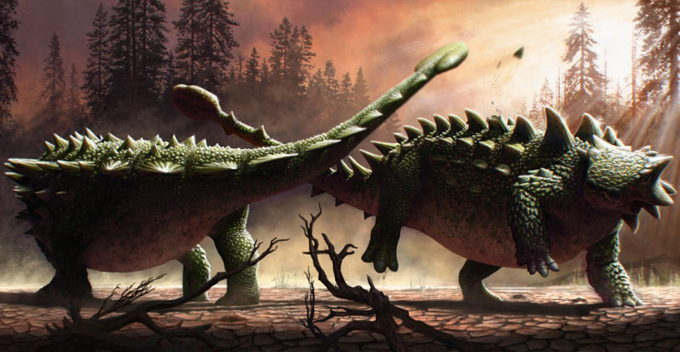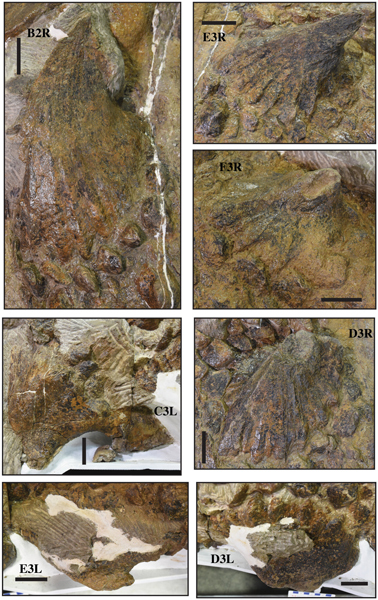Ankylosaurs battled each other using their tail clubs for social dominance in intraspecific combat. A recently published scientific paper on the ankylosaur Zuul crurivastator suggests that these armoured dinosaurs used their tail clubs to bash each other as well as to fend off tyrannosaurs.
In the study, published in “Biology Letters” the research team, examined the osteoderms of the remarkably well preserved Zuul crurivastator, an armoured dinosaur described from fossils found in the Coal Ridge Member of the Judith River Formation (Montana). Several of osteoderms along the flanks show signs of damage and healing which led the scientists to postulate that these dinosaurs battled each other with their tail clubs. These fights would have been for social or territorial dominance, perhaps even a result of a “rutting” season fighting for mates – behaviour associated with many mammals today.

Zuul crurivastator
Named and formally described in 2017, Zuul crurivastator (pronounced Zoo-ul cruh-uh-vass-tate-or) roamed the northern part of Laramidia approximately 76 million years ago (Campanian faunal stage of the Late Cretaceous).
To read Everything Dinosaur’s 2017 blog post about the fossil discovery: Zuul – The Destroyer of Shins.
Zuul’s body was covered in bony plates (osteoderms) of different shapes and sizes and the ones along its flanks were particularly large and spiky. Interestingly, the scientists which included lead author and renowned ankylosaur expert Dr Victoria Arbour (Royal British Columbia Museum, Canada), noted that dermal armour near the hips on both sides of the body showed damage that had subsequently healed. This localised, bilaterally symmetrical pathology is speculated to have been caused by ritualised combat rather than wounds inflicted by an attacking theropod dinosaur.

An Exciting Piece of the Ankylosaur Puzzle
Dr Arbour commented:
“I’ve been interested in how ankylosaurs used their tail clubs for years and this is a really exciting new
piece of the puzzle. We know that ankylosaurs could use their tail clubs to deliver very strong blows to an opponent, but most people thought they were using their tail clubs to fight predators. Instead, ankylosaurs like Zuul may have been fighting each other.”
The genus name honours a fictional monster from the 1984 film “Ghostbusters”, whilst the trivial part of the binomial name translates as “the destroyer of shins”, a nod to the idea that tail clubs were used as defensive weapons to deter attacks from predatory theropod dinosaurs. The substantial club on the end of the three-metre-long tail being used to bash into the lower legs of tyrannosaurs. This new research does not refute the idea that these tail clubs had a role in defence, but based on the pathology seen in the Zuul holotype (specimen number ROM 75860) the scientists propose that sexual selection and intraspecific combat drove their evolution. Many mammals today such as deer, antelope, cattle and sheep have horns and antlers that have evolved for use in battles between members of the same species.

It had been suggested previously that ankylosaurs may have clubbed each other, and that broken and healed ribs could provide evidence to support this idea. Unfortunately, ankylosaurid skeletons are extremely rare in the fossil record, these animals were not common, even in the Late Cretaceous of North America, where the ecosystem was dominated by other ornithischian dinosaurs such as duck-billed dinosaurs and ceratopsians.
Implications for Ankylosaur Behaviour
The remarkable Zuul fossil skeleton provides palaeontologists with an opportunity to study pathology recorded on the bones and dermal armour.
Co-author Dr David Evans (Curator of Vertebrate Palaeontology at the Royal Ontario Museum) explained:
“The fact that the skin and armour are preserved in place is like a snapshot of how Zuul looked when it
was alive. And the injuries Zuul sustained during its lifetime tell us about how it may have behaved and
interacted with other animals in its ancient environment.”
Tail Clubs for Social Dominance
The researchers conclude that the imposing tail club of Zuul could have been used in defence when needed, but the analysis suggest that sexual selection drove the evolution of this weapon. This finding has consequences for how palaeontologists perceive ankylosaurs. It suggests that these dinosaurs were capable of complex behaviours and that they likely engaged in ritualised combat over mates or for social dominance as inferred in other types of dinosaurs and observed in living mammals and birds.
To view a replica of the armoured dinosaur Zuul and other prehistoric animal models (whilst stocks last): Armoured Dinosaurs and Prehistoric Animal Figures (Wild Safari).
Everything Dinosaur acknowledges the assistance of a media release from the Royal Ontario Museum in the compilation of this article.
The scientific paper: “Palaeopathological evidence for intraspecific combat in ankylosaurid dinosaurs” by Victoria M. Arbour, Lindsay E. Zanno and David C. Evans published in Biology Letters.






Leave A Comment